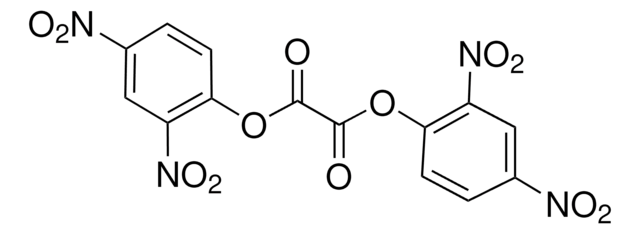75707
Bis(2,4,6-trichlorophenyl) oxalate
BioReagent, suitable for chemiluminescence, ≥99.0% (AT)
Synonim(y):
2,4,6-Trichlorophenyl oxalate, Oxalic acid bis(2,4,6-trichlorophenyl) ester, TCPO
About This Item
Polecane produkty
linia produktu
BioReagent
Próba
≥99.0% (AT)
Postać
crystals
mp
187-193 °C
przydatność
suitable for chemiluminescence
ciąg SMILES
Clc1cc(Cl)c(OC(=O)C(=O)Oc2c(Cl)cc(Cl)cc2Cl)c(Cl)c1
InChI
1S/C14H4Cl6O4/c15-5-1-7(17)11(8(18)2-5)23-13(21)14(22)24-12-9(19)3-6(16)4-10(12)20/h1-4H
Klucz InChI
GEVPIWPYWJZSPR-UHFFFAOYSA-N
Szukasz podobnych produktów? Odwiedź Przewodnik dotyczący porównywania produktów
Komentarz do analizy
Inne uwagi
Hasło ostrzegawcze
Warning
Zwroty wskazujące rodzaj zagrożenia
Zwroty wskazujące środki ostrożności
Klasyfikacja zagrożeń
Eye Irrit. 2 - Skin Irrit. 2 - STOT SE 3
Organy docelowe
Respiratory system
Kod klasy składowania
11 - Combustible Solids
Klasa zagrożenia wodnego (WGK)
WGK 3
Temperatura zapłonu (°F)
Not applicable
Temperatura zapłonu (°C)
Not applicable
Środki ochrony indywidualnej
dust mask type N95 (US), Eyeshields, Gloves
Certyfikaty analizy (CoA)
Poszukaj Certyfikaty analizy (CoA), wpisując numer partii/serii produktów. Numery serii i partii można znaleźć na etykiecie produktu po słowach „seria” lub „partia”.
Masz już ten produkt?
Dokumenty związane z niedawno zakupionymi produktami zostały zamieszczone w Bibliotece dokumentów.
Klienci oglądali również te produkty
Nasz zespół naukowców ma doświadczenie we wszystkich obszarach badań, w tym w naukach przyrodniczych, materiałoznawstwie, syntezie chemicznej, chromatografii, analityce i wielu innych dziedzinach.
Skontaktuj się z zespołem ds. pomocy technicznej










